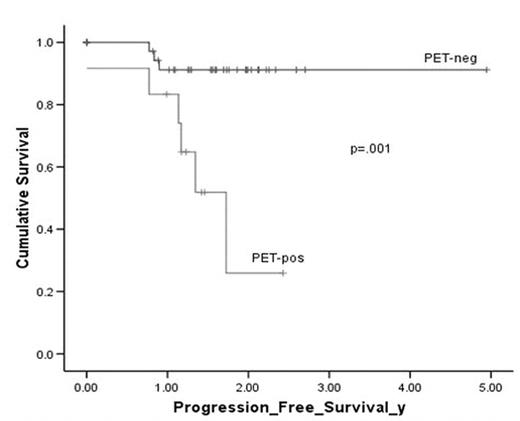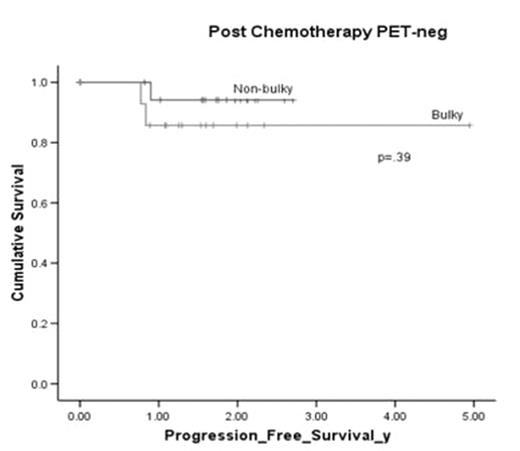Abstract
Consolidative radiotherapy (RT) is often administered following chemotherapy for advanced stage Hodgkin lymphoma (HL) with bulky disease at diagnosis or for residual abnormalities on post-chemotherapy CT imaging. It is unknown whether RT is necessary for such patients if the residual mass is FDG-PET-negative (PET-neg) following chemotherapy (CHT). Further, it has been previously shown that a post-therapy PET-positive (PET-pos) scan is highly predictive of future relapse; however, it is unclear whether consolidative RT can be used to salvage these cases.
Methods Since July 2005, adult (> 16 y) patients in British Columbia (BC) with advanced stage HL (stage III /IV and/or the presence B symptoms and/or bulky disease (> 10cm)) have been treated with 6 cycles with ABVD followed by a PET scan for further treatment planning if residual abnormalities ≥2 cm were observed on CT imaging. Prior to this, post-treatment PET scans were obtained in some individuals by self-pay. If the PET scan was positive, RT was administered if feasible, otherwise, patients were observed. There were 68 eligible patients, including 7 self-pay patients, that were identified in the BC Lymphoid Cancer Database. 16 patients were excluded (PET not performed (5); palliative tx or refusal (3); composite lymphoma (1); progressive disease during CHT or at the time of PET scan (4); HIV + (1); PET mid-therapy (1); death due to unrelated cause prior to PET scan (n=1).), leaving a total of 52 patients who had a PET scan post-chemotherapy for a residual mass and who had adequate follow-up (median 19 m, 10–59 m). Patient characteristics include: M:F 1.1:1, Median age 29 (17–81); 55% stage II, 46% stage III/IV 44%; 49% bulky disease; 69% B symptoms; IPFP Prognostic score 0 8%; 1 39%; 2 26%; >3 26%.
Results In total, 40/52 (77%) were PET-neg and 12/52 (23%) were PET-pos (SUV mean 4.4, 2.2–6.8). PET-pos patients had an inferior 2 y PFS compared to PET-neg patients (26% vs 91%, p=.001). In the PET-pos group, 10/12 received the planned RT and 5 have relapsed. In the PET-neg group, there was no difference in the 2 y PFS in patients with bulky (n=17) vs non-bulky disease (n=20) (86% vs 94%, p=.35).
Conclusions Advanced stage HL patients who achieve a post-CHT PET-neg status are at a low risk of relapse and do not require additional consolidative RT thus avoiding potential long-term side effects. The majority of patients with bulky disease who have a PET-neg scan following CHT also remain in remission, however, longer follow-up is still needed. Although some patients with a positive PET-scan may be salvaged by consolidative RT, a high proportion ultimately relapse.
Author notes
Disclosure:Consultancy: Roche Global, Biogen Idec. Research Funding: Roche CanadaAmgen, Bayer Healthcare, Genitope, Eli Lilly, Merck. Honoraria Information: Roche Canada, Roche Global, Eli-Lilly Amgen, Berlex, Celgene, Favrille, Genentech/Biogen, GlaxoSmithKline, Hana.



